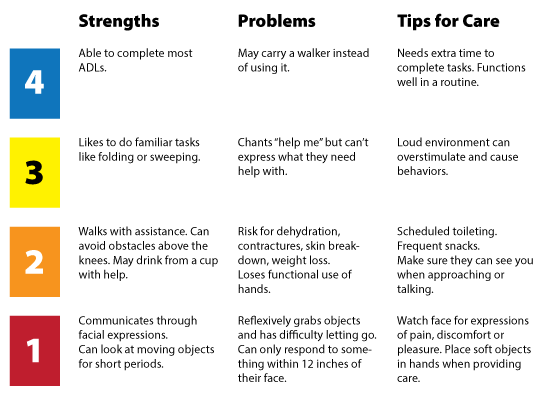
What Do Life Story Boards Do?
Life Story Boards share information about the resident gathered in the Life History Profile with caregivers, family and visitors. Each board identifies the stage of dementia via a facility-based color-coding system. Not only do the boards communicate meaningful information about residents in an easy-to-understand format, but they also provide opportunities for residents to have quality interactions with staff throughout the day.

Results: Improving the Quality of Care With Measurable Success
In addition to the measurable results, we’ve seen subjective success as well. Family and staff have reported decreases in negative behaviors, and front-line caregivers are problem-solving with abilities-appropriate solutions. Residents also have increased participation in out-of-room activities.

Next Steps: Starting Your Own Life Story Board Program
Here’s what you’ll need in order to start your own Life Story Board Program:
- A multidisciplinary team with different perspectives who “share the vision”
- Administrative support and commitment
- Passionate, visionary therapists with a minimum of specialized dementia training
- A dedicated, organized IDT leader
- Openness to “out of the box” ideas and intelligent risk-taking
Here are some examples of ways to use Life Story Boards throughout your facility:
- With lower-level patients — Used to inform caregivers about what was meaningful to the resident and to paint the picture of who that person was, though he or she may not be able to interact with the board
- With higher-level patients — Used to promote meaningful conversation and reminisce with caregivers through pictures and word prompts
- With Abilities Care interdisciplinary teams — Used to incorporate abilities-appropriate, resident-centered information into individualized treatment strategies, behavioral approaches and interventions as part of specialized dementia care plans
- For use as a bridge — Used with the family during care conferences, to enhance new employee orientation, as an ongoing Abilities Care training tool and to ease the care transition when staff assignments change
Implementing Life Story Boards entails training your staff to recognize the meaning of the four color-coded dementia levels. The long-term goal is for staff to understand the associated strengths, challenges and care strategies associated with those levels. From there, they are best equipped to implement that knowledge expertly in providing resident-centered, abilities-driven care.
